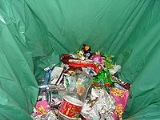
; such as urea
, sweat
or feces
. Litter
is waste which has been disposed of improperly. Feces contain large quantities of fresh and soft texturized waste products.
Waste is directly linked to human development, both technologically and socially.
There must be a reason why some people can afford to live well. They must have worked for it. I only feel angry when I see waste. When I see people throwing away things we could use.
: Mother Teresa (1910–1997), A Gift for God, 1975
![]()
The ocean is tired. It's throwing back at us what we're throwing in there.
: Frank Lautenberg, US Senator, on cases of dumped waste washing ashore at beaches, quoted in USA Today, 11 August 1988
![]()
Source Reduction is to garbage what preventive medicine is to health.![]()
To waste, to destroy our natural resources, to skin and exhaust the land instead of using it so as to increase its usefulness, will result in undermining in the days of our children the very prosperity which we ought by right to hand down to them amplified and developed.![]()

